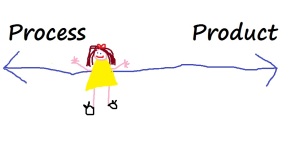I’ve recently noticed a lot of articles and blog posts being published about this debate in early childhood education. It’s a pretty important topic, and I am still trying to form an eloquent expression of where I stand on it. I thought I would use today’s post to start getting my thoughts together on the subject.
Process v. Product
The process side argues that the finished art is not the most important part; that is, that allowing the children to express themselves and also learn to create on their own is more important than churning out perfect, identical product. The child should do all parts of the project themselves, regardless of if things are glued in the right places or if the paint is in the right spot, because the process of creation is more important.
Product is basically the exact opposite of the this. Art projects should be identical, directions should be followed to the smallest detail, and if a child begins to veer off course, a teacher should guide the child back (even going so far as to fix the work.)
So where do I stand?
I stand somewhere in the middle, but mostly over on the Process side. I do not think that kids should be forced to color things a certain color, or that if they glue the legs or hands on backward, that their art is not good. I think creative expression is the most important thing for early childhood art, even if it is not perfect. Imagine if you enter your child’s classroom and see a wall full of ladybugs that the class made for the letter L. Would you rather see a wall full of cookie-cutter ladybugs, or would you rather see imperfections that shout out “I DID THIS MYSELF, MOM?”
I would rather see the imperfections any day. Even if the art isn’t perfect, the child did every last bit himself or herself and is proud of that. How can a child be proud of art they brought home that had to be fixed or altered to adhere to some ideal of what the perfect product should look like?
However.
It’s important for a child to learn to follow directions. As important as creative expression is, following directions is incredibly important, especially in my kids that are about to leave for “big” school. They need to learn how to listen and hear what’s most important, and following directions on an art project does help them to do that.
Can you combine these two sides and find a happy medium?
I think so.
When we are working on projects out of our workbooks, we follow the directions. We don’t veer too far from the beaten path. But when we work on our own art projects, we allow for creative expression. It doesn’t bother me if they don’t glue the legs in the right spot or if the hands are backward. This allows my kids to have a happy medium between following directions and being allowed artistic freedom.
I think both sides, process and product, are beneficial in the classroom. If you can find a place in the middle, your kids will be all the happier for it.
Where do you stand?
A

This reminds me of the typical conversation I hear now about freshman English composition classes. In high school, you learn the five paragraph theme (which you quickly learn is pretty useless for advanced writing). And in high school there is no deviation. Yet, in 101 or 102 classes, you are being told that you have to deviate. You have to show a bit more creativity. And it’s a shock. Having these rules drilled into your head, and then being told to discard them. And it’s hard for the kids. So it’s a similar issue about whether at a young age should you be focusing on adherence to rules or fostering creating thinking and analysis. And while I feel that it is important to have a structural base (for, as you say, following direction and such) creativity should be encouraged. Especially for the little ones. There is plenty of time for rules later.
That’s really interesting! I always hated the five-paragraph format. It just felt like the same old, tired, boring thing. I was bored writing them and was even more miserable reading over them. I agree with you- plenty of time for rules later! That’s why I do stress them with the workbooks, but there are only about four art projects to stretch over a whole month. Meanwhile, I do at least six art projects outside the workbook throughout a month, plus they can color during playtime if so inclined, and I never give them any directions on those papers- plenty of time to flex those creative muscles! =)